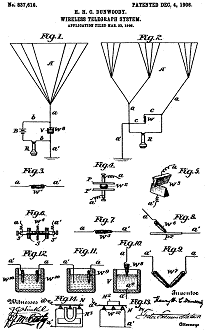Electronics & High Technology Components
- See Full List of AI Topics -

U.S. Patent No. 837,616
The "carborundum"
signal detector, an innovative device developed by engineer General H. H. C. Dunwoody
in the early 20th century, represents a significant advancement in radio technology,
particularly in the context of crystal detectors used for receiving radio signals.
This device utilized the unique properties of silicon carbide, also known as carborundum,
which was synthesized in the late 19th century by Edward Goodrich Acheson. The connection
between Dunwoody and the material lies in the application of carborundum as a semiconductor
in radio signal detection.
The operational theory of the carborundum signal detector is rooted in its ability
to rectify alternating current (AC) signals. When radio waves, which are essentially
electromagnetic waves, hit the carborundum crystal, the material allows the signal
to pass in one direction while blocking it in the opposite direction. This phenomenon
occurs due to the semiconducting properties of silicon carbide. The structure of
carborundum features a crystalline lattice composed of silicon and carbon atoms,
creating energy bands that facilitate the flow of electricity. When a radio frequency
(RF) signal is applied, the carborundum crystal's conductivity changes, enabling
it to detect the modulated signals carried by the waves. This process of rectification
allows weak radio signals to be transformed into a usable audio signal, making it
essential for early radio receivers.
 Dunwoody's invention of the carborundum signal detector can be traced back to
his work in the context of early wireless communication. During the late 1890s and
early 1900s, as radio technology was rapidly evolving, the demand for more efficient
and reliable detection methods became apparent. Recognizing the potential of carborundum,
Dunwoody experimented with different configurations of the crystal to enhance its
performance as a detector. His efforts culminated in the filing of a patent for
the carborundum detector on March 20, 1906 (U.S. Patent No. 837,616). This patent
outlined the design and operation of the detector, emphasizing the use of silicon
carbide as a medium for rectifying radio signals. Dunwoody's invention of the carborundum signal detector can be traced back to
his work in the context of early wireless communication. During the late 1890s and
early 1900s, as radio technology was rapidly evolving, the demand for more efficient
and reliable detection methods became apparent. Recognizing the potential of carborundum,
Dunwoody experimented with different configurations of the crystal to enhance its
performance as a detector. His efforts culminated in the filing of a patent for
the carborundum detector on March 20, 1906 (U.S. Patent No. 837,616). This patent
outlined the design and operation of the detector, emphasizing the use of silicon
carbide as a medium for rectifying radio signals.
The timeline of the carborundum signal detector's development closely aligns
with the broader advancements in radio technology during the early 20th century.
Acheson first synthesized silicon carbide in 1891, and it gained recognition for
its hardness and durability. However, it was not until Dunwoody's exploration of
its electrical properties that its application in radio technology became evident.
The patent granted to Dunwoody in 1906 marked a significant milestone, as it provided
a foundation for the use of carborundum in crystal radio receivers. These detectors
became vital components in early wireless telegraphy and communication systems,
allowing for improved signal clarity and reliability.
H. H. C. Dunwoody was born on March 2, 1842, in the United States. He had a distinguished
military career, serving as an engineer in the U.S. Army. His education at the United
States Military Academy at West Point laid the groundwork for his future endeavors
in engineering and technology. Throughout his military service, Dunwoody held various
positions that combined engineering and leadership, eventually rising to the rank
of Brigadier General. While his military accomplishments were notable, Dunwoody's
legacy is further enriched by his contributions to radio technology and the invention
of the carborundum signal detector.
The derivation of the name "carborundum" reflects its composition, a combination
of "carbon" and "corundum," the latter being a naturally occurring mineral composed
of aluminum oxide, known for its hardness. Acheson coined the term to describe the
synthetic material he created, and it became widely recognized in industrial applications,
particularly as an abrasive. The use of carborundum in Dunwoody's detector exemplifies
its versatility, transitioning from an abrasive medium to a critical component in
electrical engineering and telecommunications.
In summary, the carborundum signal detector invented by General H. H. C. Dunwoody
signifies a remarkable intersection of material science and electrical engineering
during a transformative era in communication technology. The combination of silicon
carbide's unique properties with innovative engineering principles led to advancements
in radio signal detection that would have lasting impacts on the development of
wireless communication systems. Dunwoody's work not only contributed to the success
of early radio technology but also laid the groundwork for future innovations in
the field. The legacy of the carborundum signal detector and its inventor continues
to be recognized in the annals of engineering and telecommunications history.
 This content was generated by primarily
the ChatGPT (OpenAI), and/or
Gemini (Google), and/or
Arya (GabAI), and/or
Grok 3 (x.AI) artificial intelligence (AI) engine.
Some review was performed to help detect and correct any inaccuracies; however,
you are encouraged to verify the information yourself if it will be used for critical
applications. In some cases, multiple solicitations to the AI engine(s) was(were) used to assimilate
final content. Images and external hyperlinks have also been added occasionally.
Courts have ruled that AI-generated content is not subject to copyright restrictions,
but since I modify them, everything here is protected by RF Cafe copyright. Many
of the images are likewise generated and modified. Your use of this data implies
an agreement to hold totally harmless Kirt Blattenberger, RF Cafe, and any and all
of its assigns. Thank you. Here are the major categories. This content was generated by primarily
the ChatGPT (OpenAI), and/or
Gemini (Google), and/or
Arya (GabAI), and/or
Grok 3 (x.AI) artificial intelligence (AI) engine.
Some review was performed to help detect and correct any inaccuracies; however,
you are encouraged to verify the information yourself if it will be used for critical
applications. In some cases, multiple solicitations to the AI engine(s) was(were) used to assimilate
final content. Images and external hyperlinks have also been added occasionally.
Courts have ruled that AI-generated content is not subject to copyright restrictions,
but since I modify them, everything here is protected by RF Cafe copyright. Many
of the images are likewise generated and modified. Your use of this data implies
an agreement to hold totally harmless Kirt Blattenberger, RF Cafe, and any and all
of its assigns. Thank you. Here are the major categories.
Electronics & High Tech
Companies | Electronics &
Tech Publications | Electronics &
Tech Pioneers | Electronics &
Tech Principles |
Tech Standards Groups &
Industry Associations | Societal
Influences on Technology
|








 Dunwoody's invention of the carborundum signal detector can be traced back to
his work in the context of early wireless communication. During the late 1890s and
early 1900s, as radio technology was rapidly evolving, the demand for more efficient
and reliable detection methods became apparent. Recognizing the potential of carborundum,
Dunwoody experimented with different configurations of the crystal to enhance its
performance as a detector. His efforts culminated in the filing of a patent for
the carborundum detector on March 20, 1906 (
Dunwoody's invention of the carborundum signal detector can be traced back to
his work in the context of early wireless communication. During the late 1890s and
early 1900s, as radio technology was rapidly evolving, the demand for more efficient
and reliable detection methods became apparent. Recognizing the potential of carborundum,
Dunwoody experimented with different configurations of the crystal to enhance its
performance as a detector. His efforts culminated in the filing of a patent for
the carborundum detector on March 20, 1906 (
